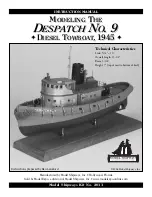
7
need to cut off the bottom of the rudder
shaft as it is too long to fit the hole in the
skeg. Sounds complicated in words, but
Figure B-3 will make it clear as mud.
4. Cutting Out & Detailing
the Freeing Ports
Layout the freeing ports in pencil first, then
drill several holes in the ports and file or saw
out the port. The ports have vertical round
bars. Use brass wire or pins included in the
kit for the bars. Installing the wire or pin is a
tricky task, so it is probably easier to drill
holes down thru the top of the bulwark and
insert the wires or pins thru the holes. Cut
the heads off if pins are used.
5. Installing Bulwark Brackets,
Stiffeners, Cap Rail, Quarter Bitts,
Chocks, & Hawse Pipe Lips
Before installing the cap rail, add the four
quarter bitts (Britannia castings - 2 each
side). Cut holes in the bulwark, one each
side, the shape of the bulwark chock castings
and glue them in place. Drill holes in the
bulwark and add the Hawse pipe lip cast-
ings. The bulwark brackets and stiffeners
should be installed next. The bracket loca-
tions are shown on the bulwark inboard
profile on the plan sheet 2 and the plan also
shows details for the brackets as fitted on the
real boat as well as for the model. For the
model, the brackets are to be cut from 1/32"
thick basswood. On the real boat, there is a
1-1/2" diameter pipe welded to the inboard
edge of the bracket plate, but that would be
a little tedious for this scale model. Between
the brackets there are up to three equally
spaced flat bar stiffeners. For the model,
use 1/32" square basswood to represent the
stiffeners (Figure B-4).
Finally, add the cap rail which is 1/32" x
3/32" basswood. At the bow and stern where
the rail curves quite a bit, cut the rail from
the 1/32" basswood sheet in the kit. From
just aft of the aft quarter bitts, there is anoth-
er rail on top of the cap rail going around
the stern. This is apparently a chafing rail for
towing lines. Use another 1/32" thick rail for
this piece. At the bow add the small platform
between the rails.
6. Installing the Outboard
Pipe Fenders
The outboard fenders on the real boat are
half pipes. For the model, pre-sand 1/16" x
1/8" wood strips to half-rounds and install
the strips. From Station 12 around the stern
the pipe transitions into a wider plate as can
be seen on the plan view. Cut this area from
the 1/8" x 1/2" wood strip and sand the
outer edge round to match the half round
fender forward. Between the cap rail and
pipe fender at the stern install the three half
round chafing pipes. Figure B-5 illustrates
the fender details.
7. Constructing the Deckhouse
General Makeup of the Deckhouse
- The
machine-carved deckhouse consists of the
main cabin and the captain’s cabin/pilot
house all in one piece. The top of the pilot
house including the visor is a laser-cut part
in 3/32" basswood. The upper deck is a
laser-cut part including a portion of the visor
from the pilot house doors aft. The portion
of the visor forward of the doors is also a
laser-cut part. The raised area behind the
captain's cabin (Cabin Trunk), the skylight,
and the stack are rectangular wood blocks
that need to be shaped to some degree. The
top of the stack is a laser-cut part.
FIG. B-6 UPPER DECK & PILOT HOUSE TOP
FIG. B-7 CABIN TRUNK, SKYLIGHT, & STACK
LASER-CUT
PILOT HOUSE TOP
FORWARD
PORTION OF VISOR,
LASER-CUT
SHAPE THE
VISORS
LASER-CUT
UPPER DECK
FIG. B-5 PIPE FENDERS
HALF-ROUND
CHAFING PIPES
EXHAUST RINGS,
LASER-CUT
STACK TOP, LASER-CUT
STACK BLOCK
(OVAL-SHAPED)
CABIN TRUNK BLOCK
STRIP ON SIDES TO
CREATE OVERHANG
SKYLIGHT BLOCK
WITH 3 AIRPORTS
CUT FROM SHEET,
ROUND OUTER EDGE
CL
1/8" HALF-ROUND






























